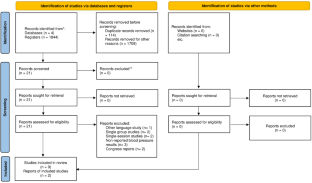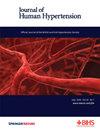普拉提方法对高血压患者的疗效:系统回顾与荟萃分析。
IF 2.7
4区 医学
Q2 PERIPHERAL VASCULAR DISEASE
引用次数: 0
摘要
本研究旨在系统回顾普拉提训练计划对高血压患者血压影响的现有证据。研究人员在四个电子数据库中检索了随机临床试验和对比研究,检索时间截至 2023 年 9 月(更新时间为 2023 年 12 月)。纳入研究的方法学质量采用物理治疗证据数据库和非随机研究方法学指数量表进行评估。共纳入 4 项随机临床试验和 7 项比较研究,方法学质量分别为低(1 项)、高(6 项)和好(4 项)。数据综合显示,参加普拉提课程的参与者收缩压和舒张压明显降低,降幅为-4.76 mmHg (95% CI: -6.55 to -2.97, p = 0.05)。本文章由计算机程序翻译,如有差异,请以英文原文为准。


The efficacy of Pilates method in patients with hypertension: systematic review and meta-analysis
This study aimed to systematically review the available evidence on the effects of Pilates training programs on blood pressure in hypertensive patients. Randomized clinical trials and comparative studies were searched in four electronic databases until September 2023 (updated December 2023). The methodological quality of included studies was assessed using the Physiotherapy Evidence Database and Methodological Index for Non-Randomized Studies scales. A total of 4 randomized clinical trials and 7 comparative studies were included, showing a low (n = 1), hight (n = 6), and good (n = 4) methodological quality. Data synthesis indicated that participants who performed Pilates program obtained significantly reduces on systolic blood pressure and diastolic blood pressure, of −4.76 mmHg (95% CI: −6.55 to −2.97, p < 0.001) and −3.43 mmHg (95% CI: −4.37 to −2.49, p < 0.001), respectively, in comparison with those included in the comparison groups. When the analysis was performed by comparing hypertensive, and normotensive patients, the results remained non-significant for blood pressure (systolic blood pressure: 0.96 mmHg (95% CI: −2.85 to 4.77, P = 0.49); diastolic blood pressure: 1.18 mmHg (95% CI: −1.23 to 3.58, P = 0.34); mean blood pressure: 1.73 mmHg (95% CI: −1.96 to 5.42, P = 0.36). Evidence suggests Pilates is safe for hypertensive patients and can be part of their rehabilitation, but it may not necessarily offer superior results or improve exercise adherence compared to other modalities.
求助全文
通过发布文献求助,成功后即可免费获取论文全文。
去求助
来源期刊

Journal of Human Hypertension
医学-外周血管病
CiteScore
5.20
自引率
3.70%
发文量
126
审稿时长
6-12 weeks
期刊介绍:
Journal of Human Hypertension is published monthly and is of interest to health care professionals who deal with hypertension (specialists, internists, primary care physicians) and public health workers. We believe that our patients benefit from robust scientific data that are based on well conducted clinical trials. We also believe that basic sciences are the foundations on which we build our knowledge of clinical conditions and their management. Towards this end, although we are primarily a clinical based journal, we also welcome suitable basic sciences studies that promote our understanding of human hypertension.
The journal aims to perform the dual role of increasing knowledge in the field of high blood pressure as well as improving the standard of care of patients. The editors will consider for publication all suitable papers dealing directly or indirectly with clinical aspects of hypertension, including but not limited to epidemiology, pathophysiology, therapeutics and basic sciences involving human subjects or tissues. We also consider papers from all specialties such as ophthalmology, cardiology, nephrology, obstetrics and stroke medicine that deal with the various aspects of hypertension and its complications.
 求助内容:
求助内容: 应助结果提醒方式:
应助结果提醒方式:


